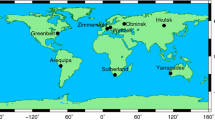Abstract
We present preliminary results of data analyses of GPS fixed point geodetic measurements of 70–260 km baselines in the Kanto-Tokai district, central of Japan. The system was introduced for the purpose of earthquake prediction researches in the district. Firstly, the analysis employs the determination of initial positions of ten sites by means of the result of the experiment using one VLBI point and one SLR point. Next, one of the station was fixed to determine other receiver locations and the wet term tropospheric delays using the orbital relaxation technique, based on the dual frequency carrier phase and surface meteorological data.
The measurements repeatability for baseline vector components was 5.4cm + (0.lppm of BL, Baseline Length) in the case taking an average of three principal axes of error ellipsoid in comparison with that of 1.9cm + (0.00ppm of BL) for the best direction under the present satellite configuration over the district, during the period 97–128 DOY of 1988.
A long term crustal deformation of the central Japan was investigated by calculating the positions of each stations at two period, April, 1988 and March, 1989. The result was in general agreement to that anticipated from the motion of the plates colliding in the area. A precursory crustal deformation prior to the 1989 volcanic eruption off east of the Izu peninsula was observed. The deformation amounted some 14cm of the baseline of length about 10km in about a week before the eruption.
The estimated path delays for wet troposphere ranged from −10 to +150cm in comparison with the calibration result of 4–20cm based on the vertical profile of meteorological data. The day-to-day variation of the path delay, however, does correlate scarcely to that of calibration and with the correction of satellite location amounting order of 50m. Those errors are thought to be caused from the potential systematic error of inaccurate satellite ephemerides. The wet tropospheric delays on highland was discussed using the estimated value by the GPS analysis software taking account of the meteorological characterisctics over the sites. A modified formula of the wet tropospheric delays was proposed and was shown to be in better agreement to the calibration data than those due to original one by Saastamoinen (1972).
Access this chapter
Tax calculation will be finalised at checkout
Purchases are for personal use only
Preview
Unable to display preview. Download preview PDF.
Similar content being viewed by others
References
Aero Service (1988). Simultaneous Orbit Network Adjustment Package, Aero Service Division, Western Atlas International.
Fujinawa, Y., Shimada, S., Kishii, T., Sekiguchi, S., Eguchi, T., Okada, Y. (1989), Estimation of tropospheric path delays using the fixed-point GPS simultaneous baseline determination network of NRCDP(1), Rep. Nat. Res. Centr. Disaster Prevention, 44, in press.
Kuroishi, Y., Murakami, M. and Tsuji, H. (1988). A simulation study on GPS double difference positioning. J. Geod. Soc. Japan, 34, 137–149 (in Japanese).
Mogi, K. (1981). Earthquake prediction program in Japan, in Earthquake Prediction — An International Review, Maurice Ewing Series, 4, 635–666.
Nakane, K. and Fujii, K. (1981). Horizontal crustal movement in KANTOTOKAI district (III), J. Geod. Soc. Japan, 27, 140–147.
Okada, Y. (1984). First results from Japanese network for earthquake prediction, Nature 312, 500–501.
Saastamoinen, J. (1972). Atmospheric correction for the troposphere and stratosphere in radio ranging of satellites, The use of artificial satellites for geodesy, Geophys. Monogr. Ser., 15, Amer. Geophys. Union, Washington D.C., 247–251.
Shimada, S., Sekiguchi, S., Eguchi, T., Okada, Y. and Fujinawa, Y. (1988). Simultaneous baseline determination network in Kanto-Tokai area, central Japan, Proc. Japanese Symp. on GPS, Jan. 27–29, 1988, 266–270.
Shimada, S., Sekiguchi, S., Eguchi, T., Okada, Y., Fujinawa, Y. (1989). Preliminary results of the observation by fixed-point GPS simultaneous baseline determination network in Kanto-Tokai district, J. Geod. Soc. Japan, 35, 85–95.
Shimada, S., Fujinawa, Y., Sekiguchi, S., Eguchi, T., Okada, Y. (1989). GPS detection of a volcanic fracture opening in Japan, submitted to Nature.
Watada, S. (1989). Relashionship between error distribution in positioning and satellites configuration in GPS technique, Master Thesis, University of Tokyo.
Author information
Authors and Affiliations
Editor information
Editors and Affiliations
Rights and permissions
Copyright information
© 1990 Springer-Verlag New York Inc.
About this paper
Cite this paper
Fujinawa, Y. et al. (1990). Some Results in the Preliminary Data Analyses of the Fixed-Point GPS Baseline Determination Network in Central Japan. In: Bock, Y., Leppard, N. (eds) Global Positioning System: An Overview. International Association of Geodesy Symposia, vol 102. Springer, New York, NY. https://doi.org/10.1007/978-1-4615-7111-7_13
Download citation
DOI: https://doi.org/10.1007/978-1-4615-7111-7_13
Publisher Name: Springer, New York, NY
Print ISBN: 978-0-387-97266-4
Online ISBN: 978-1-4615-7111-7
eBook Packages: Springer Book Archive




